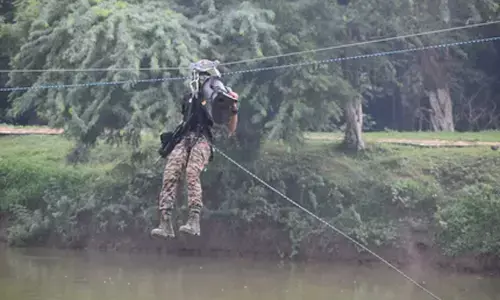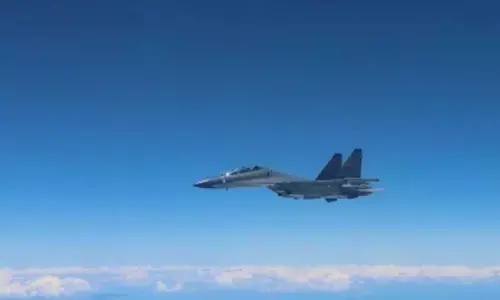Playing with fire
Playing with fire, S Madhusudhana Rao, Taliban group, Tehrik-e-Taliban Pakistan. That may be a new worry for the government.
Pakistan, at last, has realised that it is riding a tiger by trying to engage the home-grown Taliban in peace talks. Since Prime Minister Nawaz Sharif came to power last year, one of his wishes has been to enter into constructive talks with the ‘good’ Taliban as Americans would like to call moderate fighters and make them cease hostilities. One of the main reasons for his government’s engagement with the Pak Taliban is to establish contacts with hardliners across the border in Afghanistan and end hostilities against the establishment and civilians within the country.
Pakistan has also other interests to befriend the Taliban on either side: First, when the US pulls out its last combat forces from the war-ravaged Afghanistan by this year-end, Islamabad wants to have a role in Afghan affairs to check India’s influence; second, since Taliban’s role in Afghanistan’s future, post-American withdrawal, is crucial for peace in both the countries, the Sharif government wants to have a fruitful dialogue with the Tehrik-e-Taliban Pakistan (TTP).
In the last few months, emissaries from both sides have had a series of secret contacts and named their respective teams to hold the talks that are aimed at laying the ground for further negotiations. But all the government efforts have proved futile when 23 paramilitary soldiers were killed on Sunday by a faction of Taliban, throwing the peace talks into disarray.
The paramilitary soldiers belonging to the Frontier Corps were abducted by a Taliban group in June 2010 and had been holding them hostage in the northwestern Mohmand tribal region, a part of lawless Waziristan where the insurgents’ writ runs large and was the target of Pak military air strikes and American drone attacks. However, they could achieve little success in containing the Taliban. But the slaying of 23 paramilitary troops in captivity what the rebels called to avenge the death of Taliban prisoners in Karachi and Peshawar was the most blatant and heinous crimes that the militant faction had perpetrated in recent times.
It appears that it was only the beginning as a Taliban spokesman has warned that more attacks would be carried out against the security forces for ‘extra-judicial killings’ by Pak authorities, a claim denied by the government. What is clear, however, is no love is lost between the two sides and they are preparing themselves for another round of prolonged strife. The Pak government had hoped that with the initiation of peace talks, calm would return to the troubled region. With the government calling them off and the Taliban threatening more assaults, the situation is back to square one.
That may be a new worry for the government. Prime Minister Sharif himself announced the holding of peace talks with the Taliban on January 29 despite skepticism among his colleagues and the military brass. Americans, who encourage peace dialogue with ‘good’ Taliban in Afghanistan to establish peace in that country and normalise relations between the government and militants, have been pressurising Sharif to launch an offensive against Pak Taliban whose bases dot the rugged region. Some sections of insurgents are also Al Qaeda sympathisers and work closely with Afghan Taliban fighters. In other words, insurgents, terrorists and militants of all hues from Afghan-Pak border region use North Waziristan as a hideout and a springboard for their cross-border raids and nefarious activities.
It was Sharif’s move that backfired and he took a calculated risk in initiating talks with the Pakistan Taliban despite the fact that the TTP had been linked to many attacks on civilian and military targets that claimed hundreds of lives. As recently as last week, a police bus was blasted, killing 13 police officers and the insurgents had claimed responsibility.
With Pakistan again preparing to take on insurgents in North Waziristan, the Obama administration has the last laugh. It has been telling the Pak government for several years that the only way to deal with the insurgents in the North is to attack their positions with the help of drones, a strategy that has created a rift between the two sides as drone attacks are believed to have killed more civilians than insurgents. Moreover, Pak military and civilian establishments are opposed to American use of drones without involving the local authorities. Now, the question is how far the Pakistanis will go in entertaining Americans to launch a fresh offensive against militants in North Waziristan?
In any case, Pakistan should have learnt some lessons from American fiasco in dealing with Afghan Taliban. Since 2009, the US has been hobnobbing with moderate Taliban and it has not achieved anything worthwhile. And, despite its best efforts, it could not convince them to give up its arms and join the mainstream. On the other hand, no change of heart and mind is discernible among the Taliban towards the civilian government. Worse, once the American support to Hamid Karzai’s government tapers off, the insurgents dream of staging a comeback.
At the same time, they also talk of peace. US efforts to politically rehabilitate the moderate Taliban through their Doha office have not cut much ice; on the contrary, Kabul had accused Washington of playing a double game by being pally with the Afghan government and its foe.
Obviously, the Taliban leadership has been playing a diplomatic game holding all the cards to its chest and not allowing anyone to peep into their contents. Whether it is Pakistan or the US, the game plan is the same – to outwit their opponent with brinkmanship. First, the US tripped; and now Pakistan. In future, if the Kabul government takes a risk, possibly it will face the same fate.
Military action does give some dividends to those fighting the insurgency. But some rapprochement is needed
at some point of time and the stakeholders need to remember that they have to ride a tiger and it is not easy to hold its reins.














